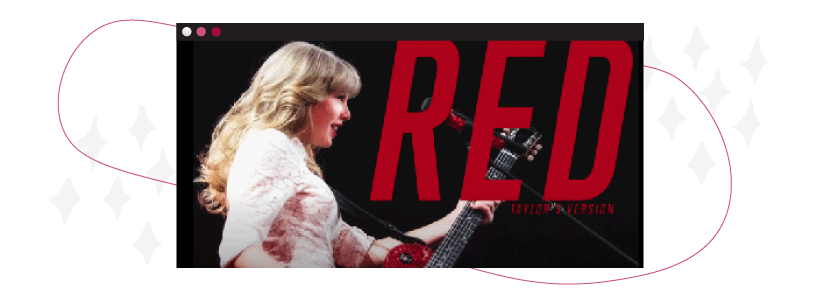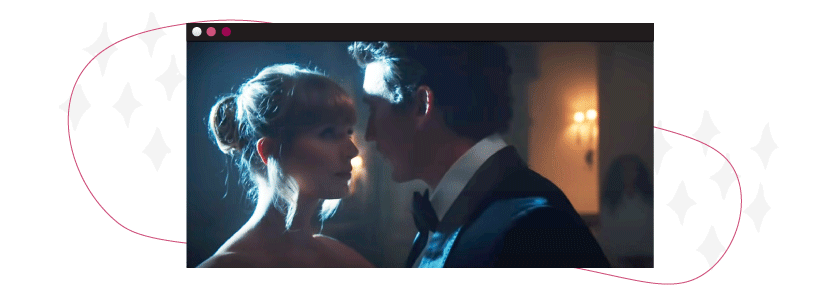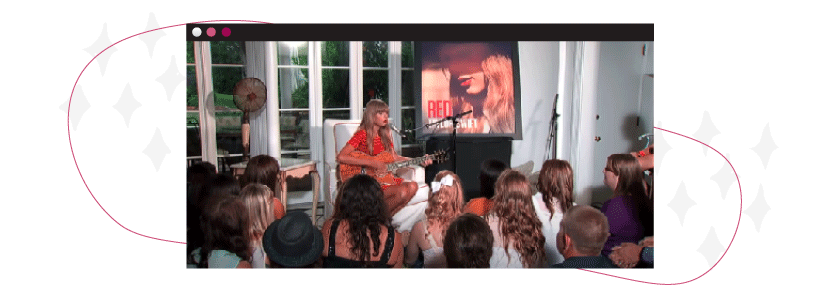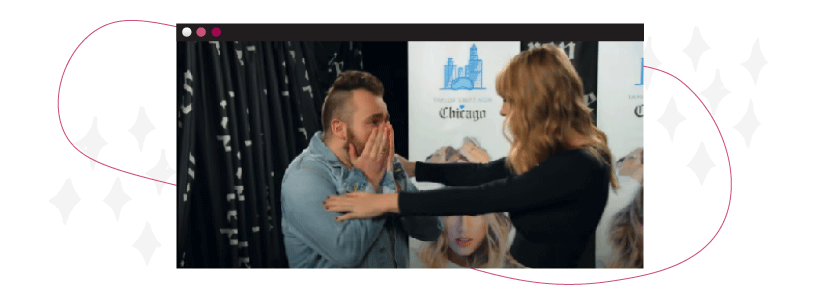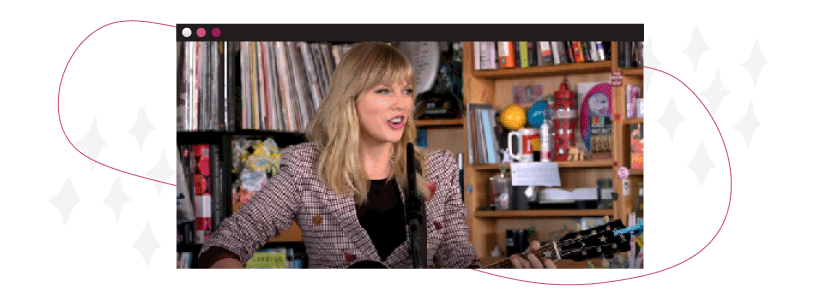Like Madonna before her (especially 80s Madonna), Taylor Swift is viewed by many as a creator of fluffy pop sensibilities. But if that’s the only way you see her, you’re not getting the full picture.
That perceived bubblegum image with mass appeal masks a sharply savvy businesswoman who understands the power of content in developing and growing a brand.
In fact, we can all learn some pretty impressive content marketing lessons from Taylor Swift.
6 Content Marketing Lessons from Taylor Swift
No matter what your niche or small business model, you can use the Swiftian model to raise your own content marketing profile, attract new audiences, inspire true fan devotion, and grow your brand. So shake it off swiftly and take a look at how you can borrow Tay-Tay’s approach for your own content marketing work.
1. Taylor Swift Took (Back) Control Over Her Brand
Late in 2020, Taylor addressed the sale of her master recordings by Scooter Braun and her prior record label, Big Machine Records, to a private equity holding company by publishing a written explanation on her social media accounts.
This was the second time such a sale of her masters had taken place, and the purchaser told Taylor (after the fact) that they’d been forbidden from talking to Swift before the sale was closed.
In response, Taylor announced she had already started to re-record her back catalog, starting with her first six albums, in an attempt to regain control of her brand and creative mission. Her fresh take on 2008’s ‘Fearless’ arrived on April 9, 2021, and ‘Red’ (Taylor’s Version) was released on Nov. 12, 2021.
The fuller context of Taylor’s re-recording of her back catalog was complex and included her long-running feud with Kanye West. However, if we’re looking at content marketing lessons from Taylor Swift, this one is fairly simple and clear: Keep control over your content and don’t let it get redirected to someone else’s hands.
In Swift’s case, the sales were legitimized by a contract she’d signed when she was 15. Once she gained a few years of experience and business acumen, she realized her content wasn’t in safe hands.
That feeling was validated when her fan base bought the album releases in droves. Swift had taken control over the underlying music and regained the upper hand by beginning the process of re-recording it.
How to make it work for you:
For content marketers, the strategy isn’t much different. Take control of your content. If something isn’t working or producing expected results, diagnose the content marketing problem and fix it.
That doesn’t mean you can’t outsource its creation, formatting, or promotion. It just means you must stay aware of the content processes carried out on your brand’s behalf. Moreover, you can’t shy away from stepping in if those processes go off-track.
In addition, consider keeping most of your content on your own blog, rather than placing it on large social networks every time you publish. This way you own your own content going forward.
2. She Mines Her Life for Her Content
Even folks who aren’t huge Taylor Swift fans and hence don’t devour every single word ever written about her probably know one key fact: She writes songs about her exes.
This is sometimes bandied about by critics and competitors as something odd or inappropriate. In fact, it’s a smart content creation strategy. (People have played videos on TikTok and Instagram Reels about Swift and her exes millions of times, which says a lot.)
How to make it work for you:
You don’t have to unload every irrelevant story from your life on your audience (Taylor certainly doesn’t). Just be willing to share the unvarnished truth about your experience with your audience.
Stories transform good content into great content, and the very best stories for content marketing are the ones that elevate, connect, and evoke an emotional response from the audience.
Share your brand stories and personalize the members of your team by sharing past events that involved them. Nothing helps you establish a winning brand through content like your or your brand’s past.
3. She Knows Her Brand and Her Audience
Next up on our list of content marketing lessons from Taylor Swift is one that can apply to all brands.
While Swift may, on occasion, push the envelope with a creative risk or two, she generally delivers the content her audience has come to love and expect.
Without enforcing an insistently uniform sound or style, she creates music and other content that delivers the emotional, aesthetic, and kinesthetic experiences her audience members embrace.
She makes sure her creative output keeps pace with evolving tastes and trends without merely imitating or duplicating them. The result is pure Taylor Swift while still seeking an authentic connection with her fans and audience members.
How to make it work for you:
You can exercise that same brand power and audience awareness by integrating modern tools and strategies that help you collect, collate, and understand relevant data and metrics about your audience and how they interact with your brand along every point in the buyer’s journey.
From awareness at the top of the funnel (TOFU) to the purchasing decision at the bottom of the funnel (BOFU), each stage in that customer’s journey presents unique needs, pain points, and desires.
Use data collection and analytical tools to get to know your audience and prospects more intimately, then use that deeper understanding to tailor (pun absolutely intended) your content accordingly.
Social listening is another tool that will help you get to know your audience and how they perceive your brand. Pay attention to the conversations surrounding your field or niche as well as your brand, specifically on LinkedIn or Twitter.
Those mentions will help you understand your audience and how they see your company more deeply, which in turn empowers you to create content that better aligns with that audience.
4. She Talks to Her Audience Where They Are and How They Like
Sure, she could simply tweet out interview links, new album announcements, and the occasional selfie, but Taylor goes far beyond such basic social media fundamentals. Taylor was quick to embrace TikTok, for example, because that’s where a lot of her young fans were already beginning to congregate online.
And what does she share on TikTok? A solid mix of funny videos of cats, music video clips, and her own take on “The Assignment,” each with its own authentic T-Swift imprint. Her audience can relate to Taylor’s commentary on the pandemic, and they respond positively to it because it comes across as real and genuine.
How to make it work for you:
By all means, this is one of the content marketing lessons from Taylor Swift that will encourage you to put your best foot forward on your brand’s social media accounts, but keep it real and authentic. Audiences today are too savvy to fall for a false voice.
Don’t try to pull the wool over their eyes and come off as something you’re not, either for yourself or your brand.
Similarly, meet your audience and prospects where they already are. If they’re not really that into Twitter, why spend your precious time and content marketing budget dollars on a Twitter-intensive strategy? Go where they are, the way Taylor meets her fans on TikTok.
5. She Understands Her Platforms
Look at Taylor’s TikTok page and compare it to her Instagram or Twitter accounts. Notice anything interesting? There might be some similarities there, but it’s not all the same.
Taylor doesn’t just hire a team of poorly paid PR interns to post the same content across all her channels without tweaking or tailoring (we can’t stop, we’re sorry). Instead, she shares content that’s well suited to each platform in a format that aligns with its needs and limitations.
How to make it work for you:
Make sure you’re sharing content in formats that suit the platform and its technical limitations. If you’re sharing a TikTok, concentrate on clipping the larger video in a way that best communicates the major message (or depicts the funniest bits fully).
If you’re composing a tweet, try to keep it succinct so you don’t have to create an extensive thread that requires audience members to read a dozen or more sequential tweets. Think about your user’s expectations and context when they encounter your content, and try to craft the best possible user experience.
6. She Encourages Fan Loyalty
The last of our content marketing lessons from Taylor Swift is about the importance of loyalty. There are Taylor Swift fans, and then there are the Swifties or superfans. And while the former is devoted to her music and other content, Taylor knows how important the latter is to her brand.
That’s why she creates unique experiences that reward their loyalty.
From pre-release listening parties in her own home to special merchandise, Swifties get treats and bonuses just for being consistently loyal. In turn, of course, these rewards simply make the super-fans even more ardently devoted.
How to make it work for you:
Don’t ignore existing customers in your lust to acquire new ones. Don’t let it get to the point where longtime customers never, ever want to get back together with you. Improve your CLV (customer lifetime value) by rewarding customer loyalty with earned and free but unique perks.
Taylor Swift’s Key Takeaway: Always Keep Your Audience Top of Mind
Like a lot of artists, Taylor Swift has a vivid, viable brand that she’s carefully built and managed over her career. Looking at the ways she’s used content of all types — from her own music to her videos and social media content — can help you more precisely target your own content for your audience.
Whether you’re targeting existing customers or prospects, you’ll want to align your content with their needs, pain points, and location along the customer’s journey (TOFU, MOFU, or BOFU). Create and promote your content mindfully, with your audience always top of mind throughout your process.
Need help developing content that highlights your brand voice, provides value to your target audience, drives loyalty, and establishes you as a thought leader in your industry? ClearVoice’s expert team of writers can do all of this and more, delivering ready-to-publish content as often as you need it. Talk to a content specialist today to learn more.
